 |
Home Page |
Fighter Aircraft World War Two 1939 - 1945 |
|
By the outbreak of WWII, Aircraft were achieving speeds of over 300 mph. The double and triple wing designs of the WWI era were unsuitable for high speed flight, this seeing all Aircraft after this time incorporating the single wing design. Most Air-to-Air victories during WWII were achieved by Guns or Cannon. Pilots normally maneuvered in behind the target letting off short burst of fire at distances between 350 and 2,000 meters. Long bursts of fire could see all the Aircrafts ammunition used up in one short Dog Fight. The German invasion of Poland 1st September 1939 set off WWII. The Japanese attack on US forces at Pearl Harbor 7th December 1941 escalated the war even further. Britain, France, Australia, New Zealand, Canada, Russia and the USA formed and Alliance, while Germany, Italy and Japan joined forces. Germany surrendered in May 1945, Japan in September 1945. WWII claimed the lives of over 50,000,000 people.
The countries to suffer the most losses in World War
II were, the Soviet Union over 21,000,000, Germany
7,000,000, Poland 6,850,000, Japan 1,800,000,
Yugoslavia 1,700,000, Romania 985,000, France
810,000, Hungary 750,000, Austria 525,000, Italy
410,000, Czechoslovakia 400,000, Great Britain
388,000 and the USA 295,000. |
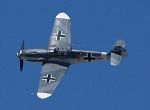
Messerschmitt Bf 109 1937, German, 398 mph The Bf 109 was produced in higher numbers than any other Fighter Aircraft in history, said to be 30,573 craft built before the end of WWII. The Bf 109 was also credited with more Aircraft kills in World War II than any other Aircraft. During the Battle of Britain, the Bf 109E had an advantage over the British Hurricane with a faster climb rate and higher top speed. The Hurricane was said to be able to turn tighter than the Bf 109, and the Spitfire. The Bf 109E was siad to be a close match for the Spitfire, with little between the Aircraft. The Bf 109 was flown by the top Fighter Ace of World War II: Erich Hartmann, with 352 confirmed victories. The Bf 109 remained in production until the end of the War, with later models upgraded to match the performance of the later Allied planes. Armed with 2 x 13 mm machine guns or 20 or 30 mm cannon. |
|
|
|
|
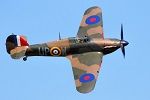
Hawker Hurricane early 1938, British, 340 mph Along with the Spitfire, the Hurricane was credited with enabling the Royal Air Force (RAF) to win the Battle of Britain during 1940, being credited with the majority of the RAF's air victories. There were about 14,000 Hurricane's built between 1938 & 1944. During the Battle of Britain, the RAF lost 1,085 planes. The Battle was fought over the British countryside, so a large percentage of Pilots survived to fly again. Germany lost 1,641 aircraft. A top Allied Pilot, the South African Pattle Marmaduke Thomas St John, scored about 26 of his 34+ kills in a Hurricane in combat over North Africa and Italy. The Hurricane was outdated by 1941, so was mainly used for Ground Support from then on. Armed with multiple 0.303 in (7.7 mm) Browning machine guns or 20 or 40 mm cannon. |
|
|

Supermarine Spitfire August 1938, British, 378 mph The Spitfire became famous during the Battle of Britain, with many people beleiving the Spitfire was the main RAF fighter of the Battle, although more Hurricane's were involved in the Battle, and shot down more German Aircraft. Air Vice Marshal, James Edgar "Johnnie" Johnson, was credited with shooting down 34 enemy Aircraft, as well as seven shared kills in various Spitfire's. He was the highest scoring Western Allied Pilot against Luftwaffe Aircraft, becoming the British, and Western Allied top flying ace. The Spitfire was upgraded throughout the War with later models capable of 448 mph. Armed with multiple 0.303 in (7.7 mm) Browning machine guns or 20 or 40 mm cannon. |
|
|

Curtiss P-40 1938, US, 378 mph The Curtiss P-40 was an American fighter and ground attack Aircraft used by many Allied nations during World War II. When production ended in November 1944, 13,738 had been built. The first P-40s to enter service lacked the performance needed to challenge the Messerschmitt Bf 109s, so were deployed to the British and French in North Africa. The P-40 was the top US Fighter in the first few years of the Pacific war against Japan, where it struggled to match the maneuvers of the Japanese A6M Zero. Armed with 6 x 50 caliber (12.7 mm) M2 Browning machine guns. |
|
|
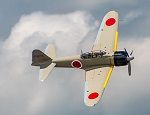
A6M Zero 1940, Japanese, 331 mph The Mitsubishi A6M Zero was a highly maneuverable, lightweight Fighter Aircraft in service between 1940 and 1945. In the early years of the war, Allied Pilots felt at a disadvantage taking on the Zero. By 1942, Allied Pilots had developed new techniques to take on the Zero on more equal terms. By 1943, American and British Fighters had greater firepower, armor, speed, and comparable maneuverability. The Zero was outdated by 1944, being shot down at a rate of 10 - 1. During the final years of the War in the Pacific, the Zero was used in many Kamikaze attacks. Armed with 2 x 7.7 mm (0.303 in) Type 97 machine guns in the engine cowling and 2 x 20 mm (0.787 in) Type 99 cannons. |
|
|

Focke-Wulf Fw 190 1941, German, 408 mph This Aircraft helped Germany gain air superiority over the English Channel in 1941. The British captured an Fw 190 in June 1942, after a German Pilot, Oblt. Armin Faber, landed on a British Airfield by mistake. Inspection of the captured Aircraft showed it could out perform British Arcraft in service at that time. This led the British to speed up development of the Spitfire Mark IX with the new two-stage supercharged Merlin 61 engine. Later versions of the Fw 190 could reach 440 mph. Armed with 2 x 13 mm machine guns and 4 x 20 mm cannons. |
|
|

de Havilland Mosquito August 1941, British, 415 mph, twin engines The de Havilland Mosquito was a British combat Aircraft used for a number of roles due to its high speed. Originally designed as an un-armed fast Bomber, the Mosquito was developed to perform daytime tactical Bombing, high altitude night Bombing, Pathfinder, and day or night Fighter. Armament was four 20 mm cannon in the front fuselage, and four 0.303 in Browning machine-guns in the nose. |
|
|
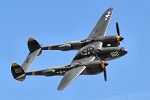
P-38 Lightning 1941, US, 443 mph, twin engines The first testing missions for the long range Lightning was escorting British Bombers into Germany, and against the Italians in the Mediterranean. Italian pilots compared the P-38 to other top Fighters such as the Spitfire. The P-38 was used more in the Pacific escorting Bombers at altitudes between 18 and 25,000ft. The P-38 was credited with destroying more Japanese Aircraft than any other US Fighter. Armed with 4 x Colt-Browning MG53-2 0.50 in machine guns and 20 mm cannon. |
|
|
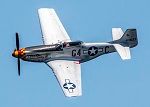
P-51 Mustang 1942, US, 437 mph The North American Aviation P-51 Mustang was an American long-range Fighter Aircraft, mainly used as a Bomber escort in raids over Germany, helping the Allies to gain air superiority in Europe from early 1944. The P-51 also had limited service in the Pacific War. A, P-51B/C carrying high-octane fuel, was fast enough to attack V-1s heading for England, and the Messerschmitt Me 262 Jet Fighters, although only for short bursts. Armed with 6 x 0.50 in (12.7 mm) machine guns. |
|
|

P-47 Thunderbolt 1942, US, 433 mph The Republic P-47 Thunderbolt, also known as the Jug, was the largest single-engined Fighter of WWII, a vast improvement on the Curtiss P-40 Warhawk. P-47Cs were sent to England for combat operations in late 1942, and first used in the Pacific with the 348th Fighter Group flying escort missions out of Brisbane/ Australia. P-47 later models, with improved speed, were one of the top Fighters in the Pacific, also able to survive a great amount of damage. Its was also credited with being a formidable ground attack Aircraft. Armed with 8 x 0.5 in (12.7 mm) M2 Browning machine guns. |
|
|

Messerschmitt Me 262 April 1944, German, 541 mph, Jet The Messerschmitt Me 262 was the world's first Jet Fighter to enter service. This Jet had little impact on the the War as it entered service only 13 months before the end of the War, with poor reliability, and few in numbers. The Me 262 was however credited with 509 Allied kills to the loss of around 100 Me 262s. If they had been developed earlier, in greater numbers, they could have had a huge impact on the War. These early Jets had poor low speed acceleration and their engines needed replaced between 12 & 50 hours of flying. Armed with 4 x 30 mm MK 108 cannons. |
|
|
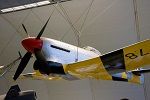
Hawker Tempest June 1944, British, 432 mph The Hawker Tempest was a British Fighter Aircraft mainly operated by the Royal Air Force in the last 11 months of the Second World War. The Tempest was one of the most powerful Fighter Aircraft used in the War, credited with shooting down a number of German Messerschmitt Me 262s. Hubert Lange, an Me 262 pilot, stated: "the Messerschmitt Me 262's most dangerous opponent was the British Hawker Tempest — extremely fast at low altitudes and highly-manoeuvrable. Armed with 4 x 20 mm Mark II Hispano cannons. A rare aircraft, very view images of it around. |
|
|

Gloster Meteor July 1944, British, 410 mph, Jet The Gloster Meteor was the first British Jet Fighter, the Allies first operational Jet. Designed by George Carter, it first flew in 1943, and entered the war 27th July 1944, with 616 Squadron of the Royal Air Force (RAF). The RAF first used this aircraft to try and shoot down V-1 flying bombs as the Meteor had a higher top speed at high altitude than propeller driven fighters of the time. There were no reports of the Meteor fighting any German Jets, as the Allies did not want Meteors flying into Germany to meet the German Jets, as if any were shot down, the Germans would have been able to view the design of their engines. At the end of the War, Meteors had been credited with destroyed 46 German Aircraft through ground attack. Armed with 4 x 20 mm British Hispano cannons. |
|
|
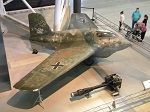
Messerschmitt Me 163 1944, German, 596 mph, rocket-powered. The Messerschmitt Me 163 Komet was the only Rocket-Powered Fighter Aircraft to enter service during the Second World War. Although the fastest Aircraft of the time, it shot down very few Allied Aircraft. Allied Pilots soon noted the short lifetime of their powered flight, so would wait till their engines ran out of fuel, then shoot the Komet down as it glided back to its airfield. Armed with 2 x 30 mm Rheinmetall Borsig MK 108 cannons. |
|
|

Heinkel He 162 April 1945, German, 562 mph, Jet The Heinkel He 162 was a single engined, Jet powered Fighter Aircraft used by the Luftwaffe in the last month of WWII, with about 120 making it into service. This Aircraft was rushed into service, made primarily of wood, due to the short supply of metal late in the War, becomming the fastest Jet Fighter of WWII, although only capable of carrying enough fuel to fly for 30 minutes. In its short service, 10 - 162s were lost to flameouts and structural failures, only two were shot down. There is only evidence of one probable shooting down of an Allied Fighter. Armed with 2 x 30 mm MK 108 cannons or 2 x 20 mm MG 151 cannons. |
|
|
| Home Page |
|
|